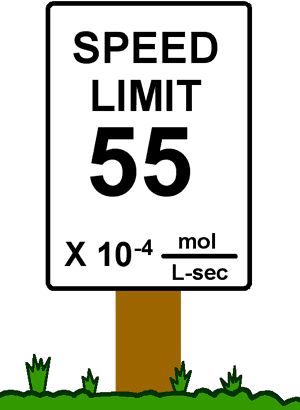|
||||||||||||
|
|
||||||||||||
Elementary KineticsIntroduction: What is Kinetics?
Biochemists use an understanding of kinetics to figure out chemical reaction rates. A rate is just a measure of a quantity that changes over time. An everyday example is the speedometer on your car that measures your rate of speed as you drive through town. Sometimes you go slow, sometimes you go fast, but it is important to know how fast you are going so that you don’t skid in a tight turn, or get a ticket for breaking the speed limit. Biochemists in the lab are similarly interested in the speed of chemical reactions they are studying, to better understand their function: while we measure miles covered per hour as we drive, chemists look at product produced per second or minute. For example, let’s say a scientist is studying the following reaction, the breakdown of hydrogen peroxide to form water and oxygen, which will happen in the presence of iodide I-(aq): 2 H2O2 She starts out with 1 liter of a 0.500 M solution of H2O2, adds the I-(aq) and after 2 minutes, measures that 0.005 mol of O2 gas has formed. What is the rate of decomposition of hydrogen peroxide in her experiment? If 0.005 mol of oxygen were created, from the reaction stoichiometry, 2 x 0.005 = 0.010 mol hydrogen peroxide must have been used up. Thus, the rate of H2O2 decomposition must be: 0.010 mol/l decomposed in 2 minutes = 5 x 10–3 mol/L/min |
 |
Copyright 2006, John Wiley & Sons Publishers, Inc. |
 |
 The word "cinema" comes from the Greek word kinema, which means movement. That makes sense, since the cinema refers to motion pictures, or movies ("move"-ies). The word kinetics is not quite as familiar; most of us are more likely to discuss the cinema than kinetics on Saturday night! However, kinetics is really a friendly word. Cousin to "cinema", kinetics draws its meaning from the same Greek root. The word "kinetics" comes from the Greek word kineein, which means "move." For chemists, kinetics involves studying how molecules move. How fast they move, how they bump into each other, and how all that results in chemical reactions.
The word "cinema" comes from the Greek word kinema, which means movement. That makes sense, since the cinema refers to motion pictures, or movies ("move"-ies). The word kinetics is not quite as familiar; most of us are more likely to discuss the cinema than kinetics on Saturday night! However, kinetics is really a friendly word. Cousin to "cinema", kinetics draws its meaning from the same Greek root. The word "kinetics" comes from the Greek word kineein, which means "move." For chemists, kinetics involves studying how molecules move. How fast they move, how they bump into each other, and how all that results in chemical reactions.